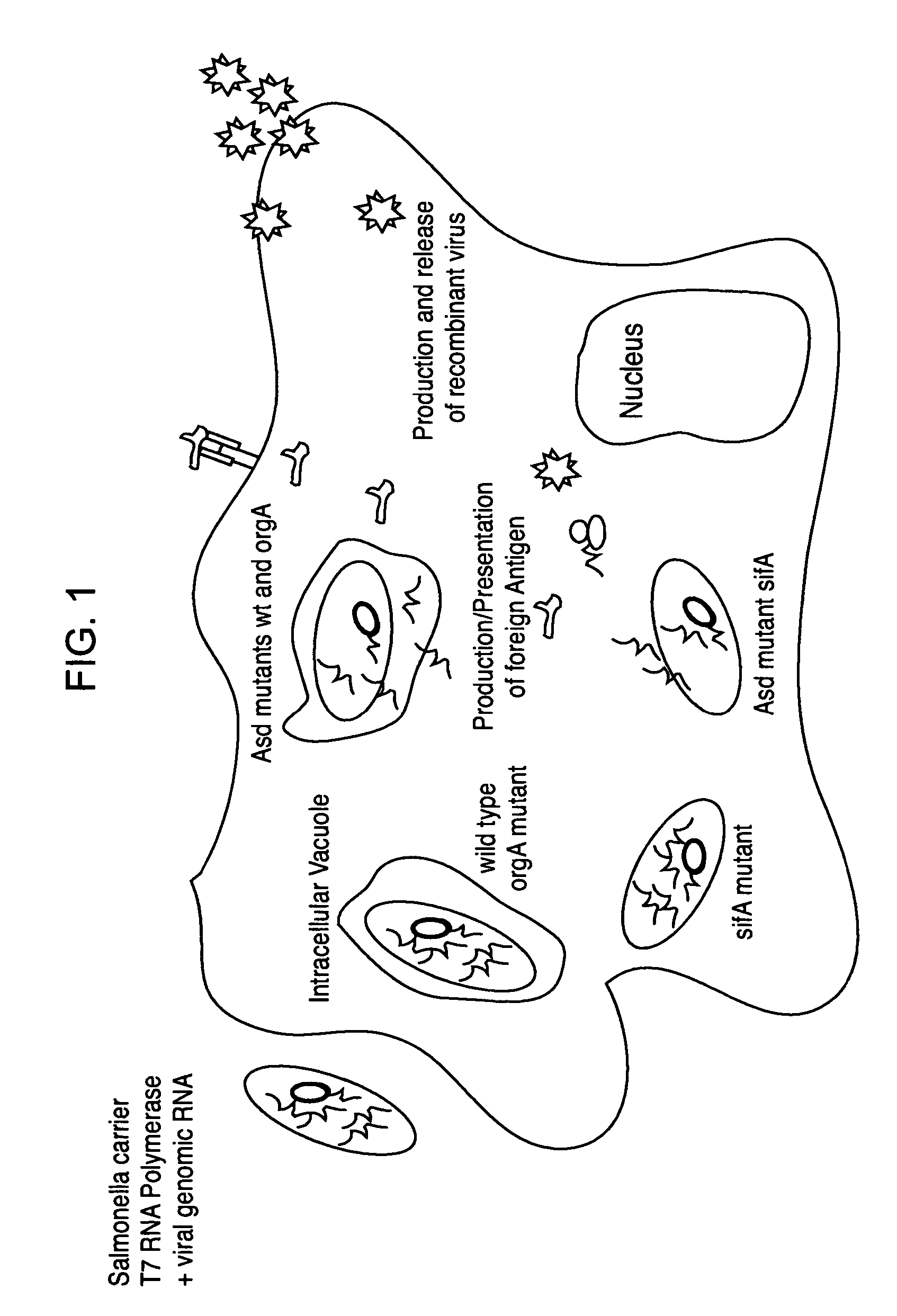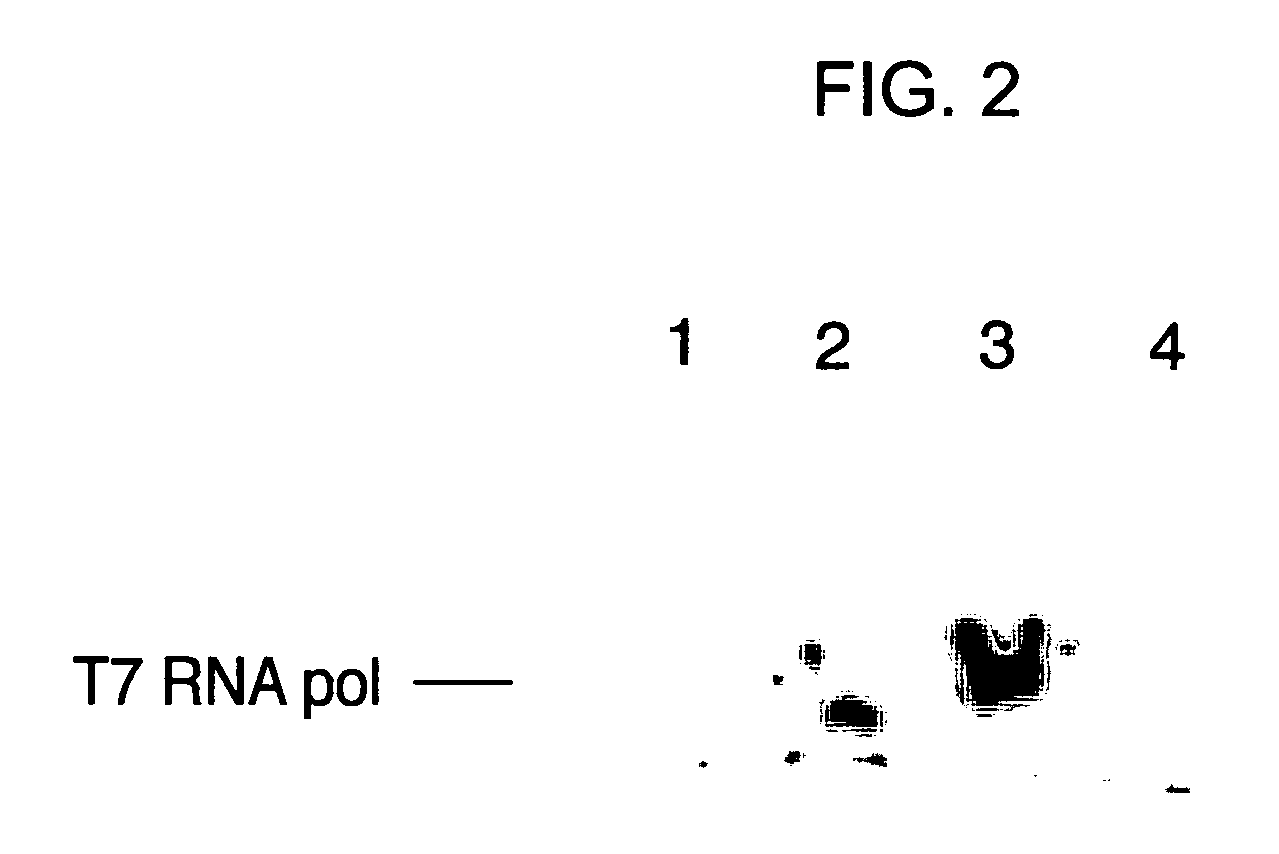Bacterial vectors and methods of use thereof
a technology of bacterial vectors and vectors, applied in the direction of antibody medical ingredients, dna/rna vaccination, genetic material ingredients, etc., can solve the problems of undesirable genetic alterations inability to replicate nor propagate dna vectors in the host cell, and insufficient delivery of gene products to cells
- Summary
- Abstract
- Description
- Claims
- Application Information
AI Technical Summary
Problems solved by technology
Method used
Image
Examples
example 1
Preparation of a Bacterial Delivery System for Delivering RNA to a Eukaryotic Host Cell
[0179]Two sets of recombinant live viruses derived from currently commercialized vaccine strains were developed—the Sabin strains of poliovirus, which have been rendered recombinant and allow the expression of foreign sequences correctly processed and cleaved from poliovirus proteins by synthetic protein cleavage sites, and the 17D strain of Yellow Fever virus, which has been engineered to express additional foreign sequences by the insertion of a second cistron. The cDNAs of poliovirus (PV) recombinants expressing the reporter protein GFP or the model antigen OVA and the cDNAs of Yellow Fever virus (YF) recombinants expressing the Luciferase protein or the model antigen p24 of HIV, have been placed under transcriptional control of the bacteriophage T7 RNA polymerase promoter and terminator. The resulting low copy plasmids are respectively, pPV-GFP, pPV-OVA and pYF-Luc, pYF-p24. HDVribozyme sequen...
example 2
Characterization and Optimization of Bacterial Delivery of Recombinant RNA Transcripts to the Host Cell
[0184]The sifA-DAP-T7+ Salmonella mutant is transformed with the pPV or pYF plasmids and grown in culture medium supplemented with DAP. Bacteria actively transcribing the recombinant RNAs are used to infect human cell lines, such as HeLa. At various times post-exposure to the Salmonella carriers, supernatants are titered to verify the production of recombinant poliovirus or Yellow Fever virus progeny, thereby confirming that the RNA transcripts were effectively delivered to the cytoplasm of the host cell by the bacteria. Alternatively, Salmonella infected HeLa cells are monitored for production of the reporter proteins (GFP or Luciferase). Production of foreign protein such as HIV p24, delivered by Salmonella transcribing the YF-p24 RNA, is confirmed by Western Blot analysis. Finally, the same procedure is applied to macrophage cell lines or primary macrophages isolated from both m...
example 3
Immunogenicity Studies In Vivo
[0185]Following characterization in cell culture of this new approach to bacterial delivery, the efficiency with which the Salmonella mutants bearing the cDNA plasmids can deliver their transcribed RNAs to mucosal cells in vivo and effectively launch the recombinant virus infection permitting expression of foreign antigen is determined. Mice are inoculated via the oral route with Salmonella carrying the PV-OVA and YF-p24 constructs. Three weeks following immunization, levels of both serum and mucosal antibodies against the 24 antigen is determined. Furthermore, the induction of both systemic and local mucosal CTL responses directed against the OVA antigen is determined by ELISPOT and flow cytometry assays. Furthermore, a comparison is made between this system and 1) the use of Salmonella to deliver simple expression plasmids encoding the same antigens, rather than recombinant infectious RNAs and 2) immunization with the recombinant live viruses alone, w...
PUM
| Property | Measurement | Unit |
|---|---|---|
| time | aaaaa | aaaaa |
| time | aaaaa | aaaaa |
| time | aaaaa | aaaaa |
Abstract
Description
Claims
Application Information
 Login to View More
Login to View More - R&D
- Intellectual Property
- Life Sciences
- Materials
- Tech Scout
- Unparalleled Data Quality
- Higher Quality Content
- 60% Fewer Hallucinations
Browse by: Latest US Patents, China's latest patents, Technical Efficacy Thesaurus, Application Domain, Technology Topic, Popular Technical Reports.
© 2025 PatSnap. All rights reserved.Legal|Privacy policy|Modern Slavery Act Transparency Statement|Sitemap|About US| Contact US: help@patsnap.com


